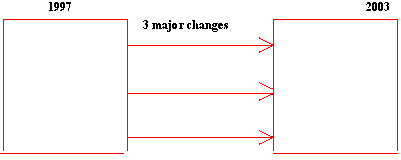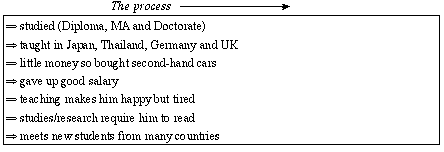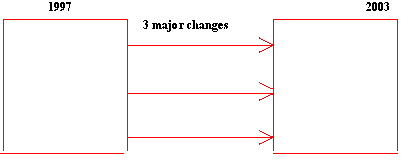Frameworking in Business English Classes
John Adamsonjohnadamson253 [at] hotmail.com
Shinshu Honan College (Tatsuno, Japan)
This article describes the teaching technique termed as "frameworking". It uses the visual device of creating boxes or "frames" in which students represent their linguistic input in short sentences, or key words. It derives from the methodology used to encourage business students to present their ideas in a concise manner, yet can also be employed with general English classes for non-business related purposes.
Introduction
"Frameworking" is a relatively new expression (Ellis and Johnson, 1994) which basically means that a student must describe change(s) between two or more things or people over a time period. It is a way of making presentations that business people often use to make everything very clear to their audience. If students travel abroad on business or meet foreign business people here, they may be required to make a presentation, so this may be a useful, visually concise style to remember.To explain what frameworking means, we need to think about the nature of many presentations with PowerPoint or OHPs. In many cases, business people make presentations about their product one year ago and the product today. Engineers may talk about research conducted five years ago and the situation now. There are many examples. If you think simply, frameworking means:
- explaining things about before
- explaining things about now
- explaining the changes between before and now took place: the process
Look at the mini example using the teacher's profile:
This information can be written on an OHT or the board/ a flip chart etc.
It shows clearly to the audience the differences between John at 25 and John
at 41. The arrow is the process of change and could be represented in many
ways. Look at the following:
So with three boxes the information is clearly shown for the audience. Remember:
before - now - the process of change
Actually the idea of frameworking is not limited to the before - now comparison only. We can look at things 10 years ago and compare them to things five years ago (life as a primary school student compared to life at secondary school). Variations of this style are used, for example, below where the development of a country can adopt various frames representing stages in its history:- The situation in Cambodia pre-1975
- Cambodia 1975-79
- Cambodia 1979-2003
- Cambodia in the future
Practice
After introducing the concept of frameworking, practice needs to be conducted. For business students, it is possible to jump directly into a work-related topic, however, lower level students may need easing into the idea by use of more general topics, such as:- their personal situation six years ago compared to now
- the economic situation in the country five or 10 or 15 or 20 years ago compared to now
- how their parents studied English compared to how they study English now
- or their choice

Language Used
The language to be employed during the process of describing the frames is often tense-related so some structural input may be necessary. Taking the first example of the teacher's profile, the following sentences could be given as models.John at 25 years old
John used to be a salesman living in Germany. He received a new car every year and had a reasonable salary etc. (PAST TENSES)
John now at 41 years old
Now he is an English teacher and lives in Japan. He drives an old car because he is very poor etc. (PRESENT TENSE)
The process
John studied how to be an English teacher and has been teaching for 17 years. He has lived in Japan since March 2002. (SIMPLE PAST TENSE + PRESENT PERFECT CONTINUOUS/SIMPLE)
Conclusion
Concluding this brief insight into frameworking, it is clear that its uses are potentially not tied just to the business class, or even to those students seeking to make presentations. I would argue that the General English class teacher can exploit the use of frames for everyday purposes. It focuses on visual clarity and conciseness in language whilst encouraging expansion of that which is on display in linguistically appropriate language. For teachers interested in finding a means to practise tenses, it is a particularly quick methodological tool to move from the past into present, and possibly, future tenses.
References
- Ellis, M. and C. Johnson (1994) Teaching Business English Oxford handbooks for teachers: Oxford University Press
- Emmerson, P. (2002) Business English Frameworks Cambridge: Cambridge University Press
The Internet TESL Journal, Vol. IX, No. 10, October 2003
http://iteslj.org/
http://iteslj.org/Techniques/Adamson-Frameworking/